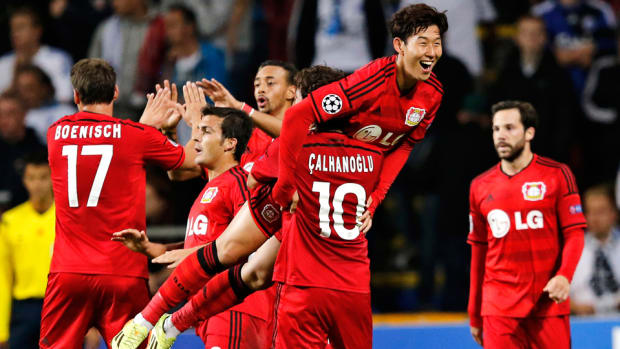Portugal—and the Rest of the World—Has Big Plans for the USWNT
The U.S. women’s national team enters its final group-stage game against Portugal needing at least a draw to advance in the Women’s World Cup, which means this could be one of the worst days in USWNT history—and one of the best days ever for the sport.
Success, in sports, is not like civil rights: The more that others have, the less there is for you. The USWNT has helped grow the game to the point where the game is harder to dominate. A monumental upset of the U.S. would announce a new era that is already well underway—and Portugal is probably the most fitting country to pull one off.
Portugal represents what women’s soccer needs: an upstart that wants to stick around and has plans to do it. Coach Francisco Neto said before the tournament that his team was hoping to “surprise,” and he mentioned the specific goal of entering its match against the U.S. with a chance to advance. But the real goal for Portugal is for winning to never be a big surprise.

Portugal opened the World Cup with a close 1–0 loss to the Netherlands, but defeated Vietnam, 2–0.
Jose Breton/IMAGO
Though Portugal has hosted one of the women’s soccer premier competitions, the Algarve Cup, since 1994, its commitment to its national team was weak until fairly recently. The country that famously produced Cristiano Ronaldo had never participated in the Women’s World Cup until this year. But its bid was not just the result of FIFA expanding the field from 24 teams to 32. Portugal is a model for how a country can transform how it looks at women’s sports—and for how sports can transform how a country looks at women.
The Portuguese Football Federation has committed to investing in the women’s game. PFF president Fernando Gomes has said the budget for women’s soccer went from €2.5 million in 2018 to €8 million this year. The number of girls and women playing soccer on teams recognized by the federation has risen seven-fold since ’11.
In the past decade, one of the country’s Big Three men’s clubs, SL Benfica, started a women’s team that has been highly successful. Another of the Big Three, Sporting CP, revived its women’s team after a 21-year hiatus. Portugal also hosted the first two UEFA Women’s Futsal Championships.
Next season, Portugal will be home to the first European league to use VAR in all games.
The federation’s Vem Jogar (Come Play) project aims to get 75,000 women playing soccer, futsal or beach soccer by 2030. For a country of more than 10 million, that might not seem like much—and it still might be hard to reach. But that, too, is a sign of how Portugal has changed: How often can we say a country’s goals for women’s sports are overly ambitious?
“I wish the country’s commitment to women’s sport had been more vigorous and had started earlier,” Gomes told CE Noticias Financieras last year. “Women make up 53% of the Portuguese population, but only six out of every 100 footballers in Portugal are women. That’s a ratio that has to change! We’ve done an excellent job, but we can’t relax.”
It is fairly easy to figure out why Portugal came to the women’s game later than Gomes would have liked. Until the 1976 Carnation Revolution, Portugal was still governed by a constitution that declared that all citizens were equal “save only the distinction due to women by reason of their nature and in the interests of the family.” Only women with a secondary education had the right to vote; men only needed to know how to read and write. Gender roles were deeply embedded, legally enforced and self-fulfilling. In 1970, 31% of Portuguese women were illiterate.
The revolution replaced opaque ceilings with glass ones. Antiquated values did not instantly disappear. The country’s 1982 Penal Code called for women who had abortions to be imprisoned for up to three years. As recently as 2017, two judges upheld light sentences for two men who violently attacked a woman because the woman was adulterous with this bit of dangerous sexism: “Society has always strongly condemned adultery by a woman and therefore sees the violence by a betrayed, humiliated man with some understanding.”
That context is relevant. Sport cannot detach itself from society; it can only pull society along. When Portugal hosted the 2014 UEFA Women’s Champions League final at Restelo Stadium in Lisbon, attendance was 11,217—a little more than half of Restelo’s capacity. But when the Champions League final returns to Lisbon in ’25, it will be played at 50,095-seat Alvalade Stadium—a sign of how much interest has increased.
As in the U.S., growth has not been linear or entirely smooth. The third Big Three club, FC Porto, still does not have a women’s side. There have been allegations of sexual harassment against men in power, and women were slow to rise to leadership positions. But just as in the U.S., one can call out injustice or slowness and still appreciate the progress that has been made.
Of the eight countries that made their World Cup debut this summer, only four—the Philippines, Portugal, Morocco and Zambia—have won a game. It is likely that none of the eight will advance to the knockout stage.
One could argue a Portugal win over the U.S. would justify FIFA’s decision to expand the field. But a better argument is that Portugal’s investment in the sport has already justified that decision.
Spots in the field serve a purpose beyond just recognizing the teams that have been playing well. They help more teams play well in the future, by spreading awareness and increasing investment and participation. Even citizenries that don’t have much appreciation for a sport understand the significance of the World Cup and will pay more attention when their team is in it.

The U.S. needs at least a draw against Portugal to move on to the knockout stages.
Erick W. Rasco/Sports Illustrated
The USWNT is proof of this. Its success has altered the way Americans view both soccer and women’s team sports. The U.S. is not just a better soccer country because of what the USWNT has accomplished; it is a better country.
The expanded format will benefit the sport; the only question is how soon. When parity comes to sports, it tends to come quicker than people expect. After the 1992 men’s basketball Dream Team dominated the Summer Olympics, the rest of the world seemed decades behind. But at the 2000 Olympics, the U.S. nearly lost to Lithuania in the semifinals—and in ’04, the Americans settled for bronze.
The U.S. is still the world’s premier men’s basketball country, but the quality of play in many other countries has increased exponentially since 1992. That forced USA Basketball to revamp its own Olympic program to maintain its status.
The USWNT could win its third straight World Cup. But if a must-at-least-tie group-stage game against a World Cup newbie is jarring, it is also welcome. As U.S. coach Vlatko Andonovski said after his team’s 1–1 draw against the Netherlands, “We’re playing good opponents. It’s not like they’re going to stand there and allow us to do what we want to do.” Portugal got moving years ago.




